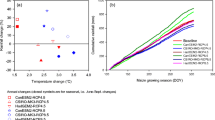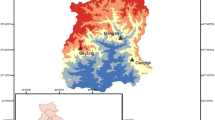Abstract
Northeast China is the main crop production region in China, and future climate change will directly impact crop potential yields, so exploring crop potential yields under future climate scenarios in Northeast China is extremely critical for ensuring future food security. Here, this study projected the climate changes using 12 general circulation models (GCMs) under two moderate Representative Concentration Pathway (RCP) scenarios (RCP 4.5 and 6.0) from 2015 to 2050. Then, based on the Global Agro-ecological Zones (GAEZ) model, we explored the effect of climate change on the potential yields of maize and paddy rice in Northeast China during 2015–2050. The annual relative humidity increased almost throughout the Northeast China under two RCPs. The annual precipitation increased more than 400 mm in some west, east, and south areas under RCP 4.5, but decreased slightly in some areas under RCP 6.0. The annual wind speed increased over 2 m/s in the west region. The annual net solar radiation changes varied significantly with latitude, but the changes of annual maximum temperature and minimum temperature were closely related to the terrain. Under RCP 4.5, the average maize potential yield increased by 34.31% under the influence of climate changes from 2015 to 2050. The average rice potential yield increased by 16.82% from 2015 to 2050. Under RCP 6.0, the average maize and rice potential yields increased by 25.65% and 6.34% respectively. The changes of maize potential yields were positively correlated with the changes of precipitation, wind speed, and net solar radiation (the correlation coefficients were > 0.2), and negatively correlated with the changes of relative humidity, minimum and maximum temperature under two RCPs. The changes of rice potential yields were positively correlated with the changes of precipitation (correlation coefficient = 0.15) under RCP 4.5. Under RCP 6.0, it had a slight positive correlation with net solar radiation, relative humidity, and wind speed.










Similar content being viewed by others
References
Alcamo J, Dronin N, Endejan M, Golubev G, Kirilenko A (2007) A new assessment of climate change impacts on food production shortfalls and water availability in Russia. Glob Environ Chang 17(3–4):429–444
Araya A, Hoogenboom G, Luedeling E, Hadgu K, Kisekka I, Martorano L (2015) Assessment of maize growth and yield using crop models under present and future climate in southwestern Ethiopia. Agric For Meteorol 214-215:252–265
Araya A, Kisekka I, Lin X, Prasad P, Gowda P, Rice C, Andales A (2017) Evaluating the impact of future climate change on irrigated maize production in Kansas. Clim Risk Manag 17:139–154
Asseng S (2013) Uncertainty in simulating wheat yields under climate change. Nat Clim Chang 3(9):827–832
Bassu et al (2014) How do various maize crop models vary in their responses to climate change factors? Glob Chang Biol 20(7):2301–2320
Cannon R (1998) The implications of predicted climate change for insect pests in the UK, with emphasis on nonindigenous species. Glob Chang Biol 4:785–796
Chen X, Chen F, Chen Y, Gao Q, Yang X, Yuan L, Zhang F, Mi G (2013) Modern maize hybrids in Northeast China exhibit increased yield potential and resource use efficiency despite adverse climate change. Glob Chang Biol 19:923–936
Diepen C, Wolf J, Keulen H (2010) WOFOST: a simulation model of crop production. Soil Use Management 5:16–24
Fischer G, Shah M, Van Velthuizen H, Nachtergaele FO (2002) Global agro-ecological assessment for agriculture in the 21st century:methodology and results. IIASA RR-02-02, IIASA, Laxenburg, Austria
Fischer G, Nachtergaele S, Prieler H et al (2008) Global agro-ecological zones assessment for agriculture (GAEZ 2008). IIASA, Laxenburg, Austria and FAO, Rome
Fischer G, Nachtergaele FO, Prieler S, et al (2012) Global Agro-ecological Zones (GAEZ v3. 0)-Model Documentation
Gao G, Jie D, Wang Y, Liu L, Liu H, Li D, Li N, Shi J, Leng C (2018) Do soil phytoliths accurately represent plant communities in a temperate region? A case study of Northeast China. Veg Hist Archaeobotany:1–13
Hutchinson M (1995) Interpolating mean rainfall using thin plate smoothing splines. Int J Geogr Inf Syst 9:385–403
Hutchinson M (1998a) Interpolation of rainfall data with thin plate smoothing splines-Part I: Two dimensional smoothing of data with short range correlation. J Geogr Inf Decis Anal 2(2):139–151
Hutchinson M (1998b) Interpolation of rainfall data with thin plate smoothing splines-Part II: Analysis of topographic dependence. J Geogr Inf Decis Anal 2(2):152–167
Izaurralde R, Williams J, McGill W, Rosenberg N, Jakas M (2006) Simulating soil C dynamics with EPIC: model description and testing against long-term data. Ecol Model 192(3–4):362–384
Jones P, Thornton P (2003) The potential impacts of climate change on maize production in Africa and Latin America in 2055. Glob Environ Chang 13:51–59
Kassie BT, Asseng S, Rötter RP et al (2015) Exploring climate change impacts and adaptation options for maize production in the central rift valley of Ethiopia using different climate change scenarios and crop models. Clim Chang 129(1–2):145–158
Liu J, Liu M, Deng S et al (2002) The land use and land cover change database and its relative studies in China. J Geogr Sci 12(3):275–282
Liu J, Liu M, Tian H et al (2005) Spatial and temporal patterns of China’s cropland during 1990-2000: an analysis based on Landsat TM data. Remote Sens Environ 98(4):442–456
Liu L, Xu X, Hu Y, Liu Z, Qiao Z (2018) Efficiency analysis of bioenergy potential on winter fallow fields: a case study of rape. Sci Total Environ 628-629:103–109
Lu X, Ren C, Wang Y, Cui F, Lu X, Gong Z (2018) Spatial difference characteristics on simulation capability of seasonal variation of air temperature simulated by three global climate models in China. Arid Land Geography 41(05):972–983
Lv S, Yang X, Lin X, Liu Z, Zhao J, Li K, Mu C, Chen X, Chen F, Mi G (2015) Yield gap simulations using ten maize cultivars commonly planted in Northeast China during the past five decades. Agric For Meteorol 205:1–10
Mao D, Wang Z, Luo L, Ren C (2012) Integrating AVHRR and MODIS data to monitor NDVI changes and their relationships with climatic parameters in Northeast China. Int J Appl Earth Obs Geoinf 18(1):528–536
Martre P, Wallach D, Asseng S, Ewert F, Jones JW, Rötter RP, Boote KJ, Ruane AC, Thorburn PJ, Cammarano D, Hatfield JL, Rosenzweig C, Aggarwal PK, Angulo C, Basso B, Bertuzzi P, Biernath C, Brisson N, Challinor AJ, Doltra J, Gayler S, Goldberg R, Grant RF, Heng L, Hooker J, Hunt LA, Ingwersen J, Izaurralde RC, Kersebaum KC, Müller C, Kumar SN, Nendel C, O'leary G, Olesen JE, Osborne TM, Palosuo T, Priesack E, Ripoche D, Semenov MA, Shcherbak I, Steduto P, Stöckle CO, Stratonovitch P, Streck T, Supit I, Tao F, Travasso M, Waha K, White JW, Wolf J (2015) Multimodel ensembles of wheat growth: many models are better than one. Glob Chang Biol 21:911–925
Meehl G, Covey C, Delworth T, Latif M, McAvaney B, Mitchell J, Stouffer R, Taylor K (2007) The WCRP CMIP3 multimodel dataset: a new era in climatic change research. Bull Am Meteorol Soc 88:1383–1394
Miao C, Duan Q, Sun Q, Li J (2013) Evaluation and application of bayesian multi-model estimation in temperature simulations. Prog Phys Geogr 37:727–744
Monteith J (1981) Evapotranspiration and surface temperature. Q J R Meteorol Soc 107:1–27
Pachauri R K, Allen M R, Barros V R, et al (2014) Climate change 2014: synthesis report. Contribution of Working Groups I, II aend III to the fifth assessment report of the Intergovernmental Panel on Climate Change. IPCC
Padgham J (2009) Agricultural development under a changing climate: opportunities and challenges for adaptation
Parry M, Rosenzweig C, Iglesias A, Livermore M, Fischer G (2004) Effects of climate change on global food production under SRES emissions and socio-economic scenarios. Glob Environ Chang 14:53–67
Pu L, Zhang S, Li F, Wang R, Yang J, Chang L (2018) Impact of farmland change on soybean production potential in recent 40 years: a case study in Western Jilin, China. Int J Environ Res Public Health 15(7):1522
Pu L, Zhang S, Yang J, Chang L, Bai S (2019) Spatio-temporal dynamics of maize potential yield and yield gaps in Northeast China from 1990 to 2015. Int J Environ Res Public Health 16(7):1211
Ruane A, Cecil L, Horton R, Gordónd R, McCollume R, Browne D, Killough B, Goldberg R, Greeley A, Rosenzweig C (2013) Climate change impact uncertainties for maize in Panama: farm information, climate projections, and yield sensitivities. Agric For Meteorol 170:132–145
Scherm H (2004) Climate change: can we predict the impacts on plant pathology and pest management? Can J Plant Pathol 26:267–273
Schmidhuber J, Tubiello F (2007) Global food security under climate change. Proc Natl Acad Sci U S A 104:19703–19708
Shortridge A, Messina J (2011) Spatial structure and landscape associations of SRTM error. Remote Sens Environ 115:1576–1587
Smith M (1992) Expert Consulation on revision of FAO methodologies for crop water requirements. Nutr Rev 43(2):49–51
Solomon S, Qin D, Manning M et al (2007) Climate Change 2007: The Physical Science Basis; Contribution of working group I to the Fourth Assessment Report of the Intergovernmental Panel on Climate Change-Summary for Policymakers. IPCC Working Groups Reports
Sun X, Ren B, Zhuo Z, Gao C, Zhou G (2006) Faunal composition of grasshopper in different habitats of Northeast China. Chinese Journal of Ecology 25(3):286–289
Tan J, Li Z, Yang P et al (2014) Spatiotemporal changes of maize sown area and yield in Northeast China between 1980 and 2010 using spatial production allocation model. Acta Geograph Sin 69(3):353–364
Tao F, Zhang Z (2010) Adaptation of maize production to climate change in North China plain: quantify the relative contributions of adaptation options. Eur J Agron 33:103–116
Tao F, Yokozawa M, Zhang Z (2009) Modelling the impacts of weather and climate variability on crop productivity over a large area: a new process-based model development, optimization, and uncertainties analysis. Agric For Meteorol 149:831–850
Tebaldi C, Knutti R (2007) The use of the multi-model ensemble in probabilistic climate projections. Philos Trans R Soc A Math Phys Eng Sci 365:2053–2075
Williams J, Jones C, Kiniry J, Spanel D (1989) The EPIC crop growth model. Trans ASAE 32:497–511
Yuji M, Kiyoshi T, Hideo H, Yuzuru M (2009) Impact assessment of climate change on rice production in Asia in comprehensive consideration of process/parameter uncertainty in general circulation models. Agric Ecosyst Environ 131(3):281–291
Zhang T, Huang Y (2012) Impacts of climate change and inter-annual variability on cereal crops in China from 1980 to 2008. J Sci Food Agric 92:1643–1652
Zhou M, Wang H (2015) Potential impact of future climate change on crop yield in northeastern China. Adv Atmos Sci 32(7):889–897
Acknowledgments
We thank the Center for Spatial Analysis, University of Oklahoma (OU), USA. We also thank Xiaocui Wu, Jilin Yang, Wen Zhuo, and HaoranYang of OU for their help.
Funding
This work was funded by the auspices of Multi-source heterogeneous data acquisition technology and data integration (No. XDA2003020301), National Key Research and Development Program (No. 2017YFC0504202), Technological Basic Research Program of China (No. 2017FY101301) and China Scholarship Council (No. 201806170212).
Author information
Authors and Affiliations
Corresponding author
Additional information
Publisher’s note
Springer Nature remains neutral with regard to jurisdictional claims in published maps and institutional affiliations.
Rights and permissions
About this article
Cite this article
Pu, L., Zhang, S., Yang, J. et al. Assessing the impact of climate changes on the potential yields of maize and paddy rice in Northeast China by 2050. Theor Appl Climatol 140, 167–182 (2020). https://doi.org/10.1007/s00704-019-03081-7
Received:
Accepted:
Published:
Issue Date:
DOI: https://doi.org/10.1007/s00704-019-03081-7




